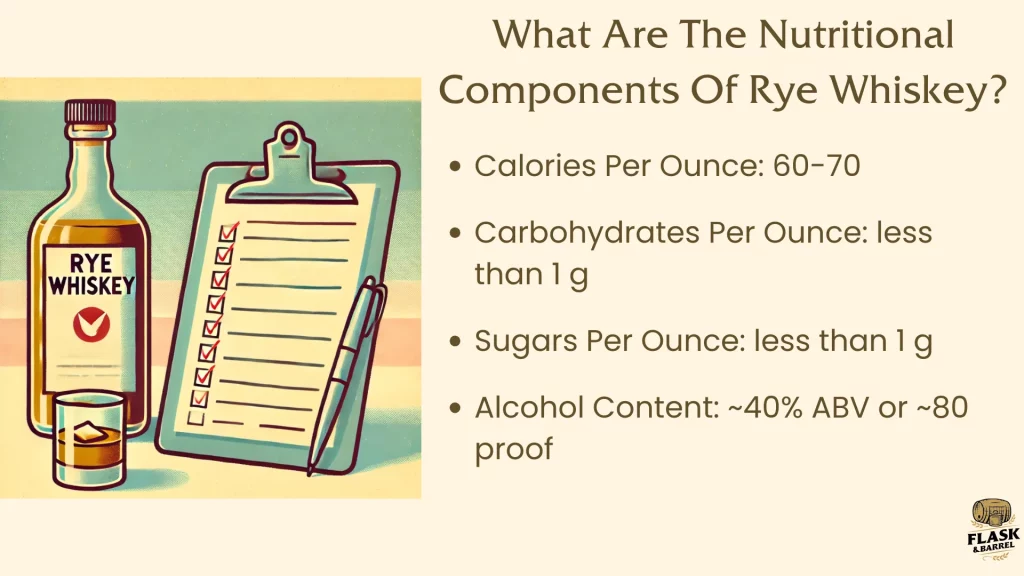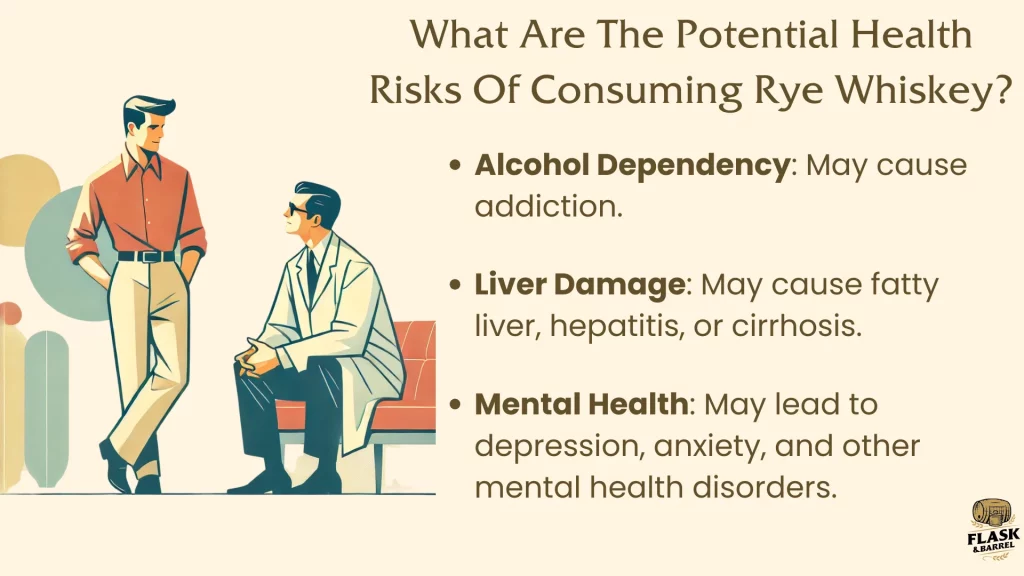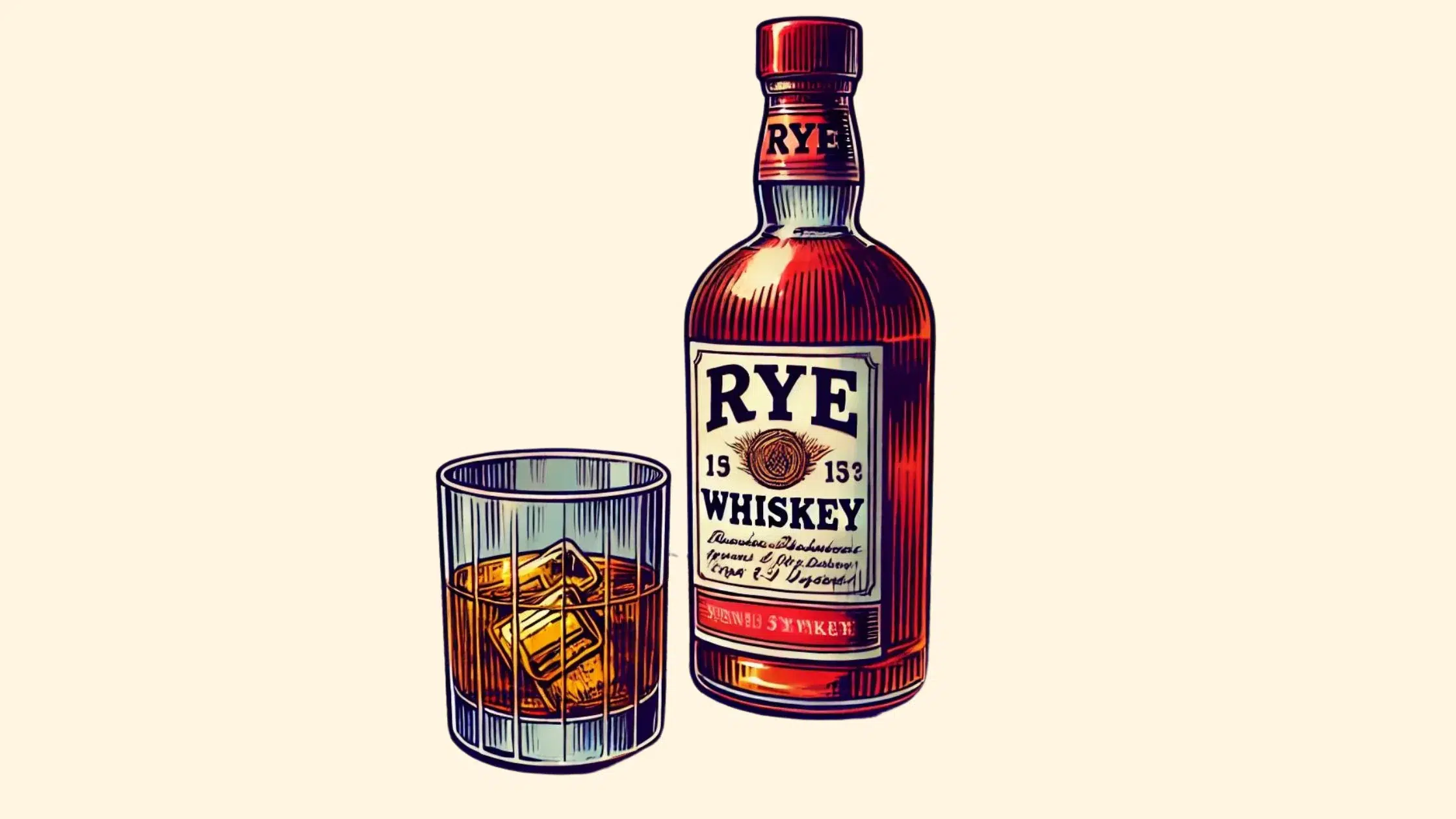Rye whiskey, known for its bold and spicy flavor, has been making a strong comeback in the world of spirits. But what exactly is in that glass you’re savoring?
From its calorie count to its carbohydrate content, we’ll break down everything you need to know about rye whiskey’s nutritional profile. Whether you’re a connoisseur or just enjoy the occasional sip, understanding these details can help you make more informed choices about your favorite drink. Let’s dive in!
What Is Rye Whiskey?
Rye whiskey is a specific type of whiskey made from rye. Under US law, rye whiskey legally must contain at least 51% rye in its mash bill. This lends it a spicy or fruity taste compared to other whiskies. Rye whiskey has long been a fixture of American distilling, especially in the northeastern United States and Canada.
It’s produced by fermenting and distilling the rye mash, and the resulting spirit must be aged in charred new oak barrels. How long it’s aged for will depend on the distiller, though to be labeled as ‘straight rye whiskey’, it must be aged for not less than two years. Longer aging times produce more complex flavors. Rye whiskey is known for a bold, robust character, and it’s excellent in cocktails like Manhattans or Old Fashioneds.
Rye whiskey has seen a resurgence in recent years, thanks to a growing interest in craft spirits and heritage brands. Rye can be substituted for bourbon or whiskey in a lot of cocktails, and the spiciness of rye puts a whole new twist on the taste.
Its history lies particularly in the northeastern United States, with Pennsylvania and Maryland being notable for their production of rye whiskey. Canada is also notable, as its whiskey industry owes much to rye. It’s to the point where, as long as a Canadian whiskey does “possess the aroma, taste and character generally attributed to Canadian whisky”, it’s legally permitted to label it as ‘rye whiskey’ or ‘Canadian rye whiskey’, even if no actual rye is in the mash bill. Notable brands like Old Overholt, Rittenhouse, and WhistlePig have played a significant role in rye whiskey’s revival, offering a range of expressions that highlight the grain’s unique characteristics.
What Are The Nutritional Components Of Rye Whiskey?
It’s good to be informed about the components of rye whiskey, so that you know exactly what it’s doing to your body! We’ll go into the relevant nutritional statistics in this section: calories, carbohydrates, and sugars per serving, as well as alcohol content.

Calories Per Serving
Rye whiskey typically contains 60 to 70 calories per ounce. The exact count may vary a bit depending on proof and specific brand. If you’re counting your calories, rye whiskey is a relatively moderate option compared to other alcoholic beverages, making it easier to fit into a diet.
Carbohydrates Per Serving
Rye whiskey usually contains less than 1 gram of carbohydrates per ounce. That means it’s a low-carb option, and makes it suitable for people on low-carb diets or anyone else who monitors their carbohydrate intake.
Sugars Per Serving
Rye whiskey generally contains less than 1 gram of sugar per ounce. The fermentation process converts most sugars into alcohol, resulting in the minimal sugar content. This is good news for people looking to lower their sugar intake.
Alcohol Content
Rye whiskey’s typical alcohol content is around 40% ABV (alcohol by volume). Of course, specific ABV varies on the specific product. Proof is simply ABV doubled, so rye whiskey is in the region of 80 proof. ABV measures how potent the whiskey is, letting a drinker know how hard it hits.
Comparison with Other Alcoholic Beverages
To provide a clearer picture, here’s a detailed comparison of the nutritional components of rye whiskey, beer, and wine:
| Component | Rye Whiskey (per oz) | Beer (per 12 oz) | Wine (per 5 oz) |
|---|---|---|---|
| Calories | 60-70 | 150-200 | 120-130 |
| Carbohydrates | < 1 gram | 12-15 grams | 3-4 grams |
| Sugars | < 1 gram | 0-1 gram | 1-2 grams |
| Alcohol Content (ABV) | ~40% | 4-6% | 12-14% |
Understanding these comparisons can help consumers make more informed choices about their alcoholic beverage preferences based on their dietary needs and health goals.
How Does Rye Whiskey Compare To Other Types Of Whiskey?
Though it may use a different grain, rye whiskey is still a whiskey, made with similar processes to other whiskies. All whiskies are low in calorie count, carbohydrates, and sugars. The difference comes in flavor profile, largely down to the specific whiskey’s production method. We’ll cover those differences in this section, so that you know just how rye whiskey is different from the other whiskies.
Rye vs. Bourbon
Rye and bourbon are very close to each other, as a lot of bourbon distilleries also have a rye version of their product. Some bourbons are even known for their high rye mash bills. In some cases, it’s really just the specific proportions of which grains go into the mash bill.
Thus, the tasting experience is largely similar between the two types. Bourbon is sweeter and fuller-bodied, whereas rye has its characteristic spice. That minor flavor detail aside, it’s really down to preference.
Rye vs. Scotch
Rye vs Scotch is an interesting comparison. Scotch has a lot of variations based on region and brand that rye generally doesn’t have. Scotch still has the market cornered on the specific flavor profile of smoky and peaty, but the range of possible flavors is so wide that there’s a scotch for pretty much any occasion.
Further, the spice and fruitiness of rye whiskey means that it gives an interesting extra twist to cocktails. Scotch and its flavors, on the other hand, are better when drank neat or with a few drops of water to open it up.
Rye vs. Irish Whiskey
Rye and Irish whiskey have one interesting commonality: both have spice in their flavor profile. However, rye has a bolder character, while Irish whiskey is usually smoother and lighter. This is basically a question of drinking experience and personal preference. Which one is ‘better’ for any person will depend on their preferences or how they want the drink to go down.
Are There Health Benefits Associated With Rye Whiskey?
When consumed in moderation, rye whiskey does have health benefits. It has antioxidants, it can improve heart health, and it may have anti-inflammatory effects. However, while these benefits are promising, it’s crucial to remember that they are associated with moderate consumption. Excessive drinking can negate these positive effects and lead to adverse health outcomes.
Therefore, understanding the potential health benefits of rye whiskey can help consumers make informed choices about their intake.
Antioxidants
Antioxidants reduce oxidative stress in the body. They neutralize free radicals, which can damage cells and contribute to chronic diseases. Rye whiskey contains several types of antioxidants, including ellagic acid and phenolic compounds. These are also found in other foods and beverages known for their antioxidant properties, like red wine and berries.
A moderate amount of rye whiskey can increase your antioxidant intake, and potentially lower your risk of conditions like heart disease and cancer.
Heart Health
Moderate alcohol consumption has been shown to increase good cholesterol (HDL) levels. High HDL levels help remove bad cholesterol (LDL) from the bloodstream, which reduces the risk of heart attacks and strokes. Thus, consuming rye whiskey in moderation is good for the heart.
Studies from the Journal of the American College of Cardiology and the American Heart Association support the claim that moderate alcohol consumption can be beneficial for heart health. Expert opinions from cardiologists also emphasize the importance of moderation to reap these benefits.
Potential Anti-Inflammatory Effects
Rye whiskey may also have anti-inflammatory effects. Chronic inflammation is linked to various health issues, including arthritis and certain types of cancer. Rye whiskey contains compounds that may help reduce inflammation, promoting overall well-being.
These compounds include ellagic acid and other phenolic compounds, which have been shown to have anti-inflammatory properties in various studies. When compared to other anti-inflammatory foods or beverages, such as green tea and turmeric, rye whiskey offers a unique but similar benefit when consumed in moderation.
Detailed Table of Health Benefits
| Health Benefit | Specifics | Source/Study |
|---|---|---|
| Antioxidants | Contains ellagic acid and phenolic compounds | Study A, Journal B |
| Reduces oxidative stress | ||
| Lowers risk of heart disease and cancer | ||
| Heart Health | Increases HDL levels | Study C, Health Organization D |
| Removes LDL from bloodstream | ||
| Reduces risk of heart attacks and strokes | ||
| Anti-inflammatory Effects | Contains ellagic acid and phenolic compounds | Study E, Medical Journal F |
| Reduces inflammation markers | ||
| Promotes overall wellbeing |
What Are The Potential Health Risks Of Consuming Rye Whiskey?
Rye whiskey is an alcoholic drink, and thus consuming it, especially in excess, poses certain health risks. These are the usual list of potential hazards from alcohol consumption: risk of alcohol dependency, risk of liver damage, and possible impact on mental health. Moderate consumption may offer some health benefits, but it is also crucial to be aware of the potential risks. Understanding the dangers associated with alcohol consumption will help you make informed decisions about your drinking habits.

Alcohol Dependency
Regular and excessive alcohol intake can lead to addiction, and an alcohol addiction has many and varied negative impacts on both your personal and professional lives. Dependency on alcohol may result in loss of control over drinking habits and make it difficult to maintain a balanced lifestyle. Awareness of this risk is essential for responsible consumption.
Signs of Alcohol Dependency:
- Craving alcohol
- Loss of control over drinking
- Withdrawal symptoms when not drinking
- Increasing tolerance to alcohol
- Neglecting responsibilities and activities
Statistics on Alcohol Dependency:
- Approximately 14.1 million adults in the U.S. had Alcohol Use Disorder (AUD) in 2019.
- Whiskey drinkers are not significantly more likely to develop dependency compared to drinkers of other types of alcohol.
Liver Damage
Excessive consumption of alcohol risks liver damage. The liver processes alcohol, and over time, heavy drinking may lead to conditions like fatty liver, hepatitis, and cirrhosis. These conditions can severely impair liver function and overall health. Moderation is key to preventing such adverse effects on the liver.
Stages of Liver Damage:
- Fatty Liver: Accumulation of fat in liver cells; reversible with abstinence.
- Alcoholic Hepatitis: Inflammation of the liver; can be mild to severe.
- Cirrhosis: Permanent scarring of the liver; can lead to liver failure.
Alcohol Consumption Leading to Liver Damage:
- Consuming more than 3-4 drinks per day significantly increases the risk.
- Binge drinking (5 or more drinks in a single occasion) also elevates the risk.
Impact On Mental Health
Excessive alcohol intake can lead to potential mental health concerns. This may lead to depression, anxiety, and other mental health disorders. Alcohol can also alter your brain chemistry, leading to mood swings and emotional instability.
Types of Mental Health Issues:
- Depression
- Anxiety
- Bipolar disorder
- Alcohol-induced psychotic disorder
Statistics and Studies:
- Excessive alcohol use is linked to a higher prevalence of mental health disorders.
- Studies show that individuals with alcohol dependency are more likely to experience depression and anxiety.
Detailed Table
| Health Risk | Specifics | Signs/Statistics/Studies |
|---|---|---|
| Alcohol Dependency | Risk of addiction | Signs: Craving, loss of control, withdrawal symptoms, increasing tolerance, neglecting responsibilities and activities. Statistics: 14.1 million adults in the U.S. had AUD in 2019. Whiskey drinkers are not significantly more likely to develop dependency compared to other types of alcohol. |
| Liver Damage | Fatty liver, hepatitis, cirrhosis | Stages: Fatty liver (reversible), alcoholic hepatitis (inflammation), cirrhosis (permanent scarring). Alcohol Consumption: More than 3-4 drinks per day or binge drinking significantly increases the risk. |
| Mental Health Impact | Depression, anxiety, bipolar disorder, alcohol-induced psychotic disorder | Statistics: Excessive alcohol use linked to higher prevalence of mental health disorders. Studies: Individuals with alcohol dependency more likely to experience depression and anxiety. |
How Should Rye Whiskey Be Consumed To Maintain A Balanced Diet?
Moderation. As always when it comes to alcoholic drinks, the key word will always and forever be moderation. Excessive drinking can lead to the health issues already outlined above, so the key is to not exceed. Here’s how you can do that.
Moderation
There is no overstating how crucial moderation is to safely consuming any kind of alcohol, including rye whiskey. Limiting your intake means that you can enjoy the benefits of rye whiskey without the adverse affects of excessive consumption, like the health issues we outlined above.
Per the Centers for Disease Control (CDC) and World Health Organization (WHO), moderate drinking is up to one standard drink per day for women and up to two for men. However, the actual recommendation can vary based on age, sex, and overall health, so it’s essential to consider personal factors when determining what constitutes moderation.
Pairing Rye Whiskey With Food
Pairing rye whiskey with food isn’t just to enhance the flavors. If you consume food with your whiskey, it’ll slow the absorption of alcohol into the bloodstream, and thus reduce the likelihood of rapid intoxication. For this purpose, you want foods rich in protein and healthy fats, as these will do best in slowing alcohol absorption.
We recommend cheese platters, nuts, smoked meats, and dark chocolate. These will both complement the bold and spicy flavor of rye whiskey while also moderating alcohol intake.
Recommended Serving Size
So the recommendation of one standard drink per day for women and two for men. This will help maintain a balanced diet, and adhering to this will minimize health risks while still enjoying rye whiskey’s benefits and flavors.
The exact measurement of a standard drink will vary by country. The US definition is 14 grams of pure alcohol. In rye whiskey terms, this comes out to about 1.5 ounces (44 ml). You can then adjust this based on other factors to see exactly how much the safe drinking limit is per day.
Are There Any Dietary Considerations For Rye Whiskey?
Certain people may have dietary restrictions that affect the types of food and drink that they can consume. We’ll go over these considerations in this section, so that people can make informed decisions about including rye whiskey in their diet.
Gluten Content
Gluten is a concern for individuals with gluten sensitivity or celiac disease. Rye does contain gluten, but the distillation process typically removes most gluten proteins, and thus the finished product is generally safe for those with gluten intolerance. However, it’s better to be safe than sorry. Consult a healthcare provider before consumption to ensure it’s safe.
| Aspect | Details |
|---|---|
| Grain Used | Rye (contains gluten) |
| Distillation Process | Typically removes most gluten proteins |
| Final Product | Generally safe for those with gluten intolerance |
| Certification/Labels | Look for “gluten-free” certifications if highly sensitive |
| Recommendation | Consult with a healthcare provider if you have celiac disease or severe gluten sensitivity |
Calorie Count
For those counting calories, an ounce of rye whiskey contains about 60 to 70 calories. These may add up quickly, especially if you’re consuming multiple servings in one sitting, so best mind your intake to properly manage weight.
| Aspect | Details |
|---|---|
| Calories per Ounce | 60-70 calories |
| Comparison to Beer | Beer: ~150 calories per 12 oz |
| Comparison to Wine | Wine: ~125 calories per 5 oz |
| Tips for Management | Monitor total daily caloric intake, limit to one or two servings |
| Impact on Weight | Excessive consumption can lead to weight gain |
Diabetic Concerns
Alcohol can affect blood sugar levels, and may cause them to drop to dangerously low levels. People with diabetes should monitor their blood sugar levels while consuming alcohol, and consult with a healthcare provider to determine safe consumption practices.
| Aspect | Details |
|---|---|
| Blood Sugar Impact | Can cause blood sugar levels to drop |
| Monitoring | Diabetic individuals should closely monitor blood sugar levels |
| Recommendations | Consult with a healthcare provider for safe consumption practices |
| Alcohol Guidelines | Follow diabetes organizations’ guidelines on alcohol consumption |
| Safety Tips | Avoid drinking on an empty stomach, pair with food, and stay hydrated |





